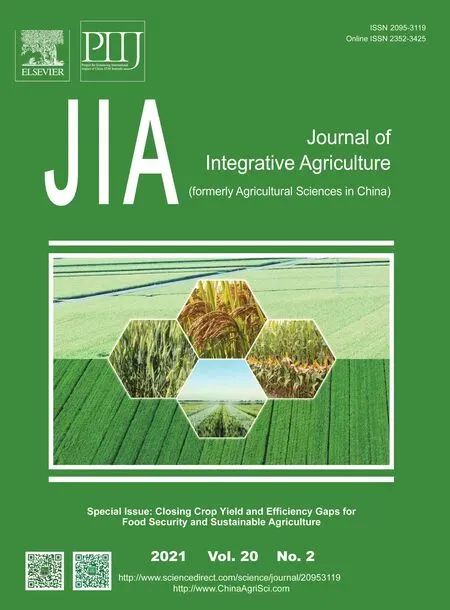lmproving winter wheat grain yield and water-/nitrogen-use efficiency by optimizing the micro-sprinkling irrigation amount and nitrogen application rate
2021-01-18LIJinpengZHANGZhenYAOChunshengLIUYangWANGZhiminFANGBaotingZHANGYinghua
LI Jin-peng ,ZHANG ZhenYAO Chun-shengLIU YangWANG Zhi-minFANG Bao-ting,ZHANG Ying-hua
1 College of Agronomy and Biotechnology, China Agricultural University, Beijing 100193, P.R.China
2 School of Agronomy, Anhui Agricultural University, Hefei 230036, P.R.China
3 Wheat Research Institute, Henan Academy of Agricultural Sciences, Zhengzhou 450002, P.R.China
Abstract Available irrigation resources are becoming increasingly scarce in the North China Plain (NCP),and nitrogen-use efficiency of crop production is also relatively low. Thus,it is imperative to improve the water-use efficiency (WUE) and nitrogen fertilizer productivity on the NCP. Here,we conducted a two-year field experiment to explore the effects of different irrigation amounts (S60,60 mm; S90,90 mm; S120,120 mm; S150,150 mm) and nitrogen application rates (150,195 and 240 kg ha–1; denoted as N1,N2 and N3,respectively) under micro-sprinkling with water and nitrogen combined on the grain yield(GY),yield components,leaf area index (LAI),flag leaf chlorophyll content,dry matter accumulation (DM),WUE,and nitrogen partial factor productivity (NPFP). The results indicated that the GY and NPFP increased significantly with increasing irrigation amount,but there was no significant difference between S120 and S150; WUE significantly increased first but then decreased with increasing irrigation and S120 achieved the highest WUE. The increase in nitrogen was beneficial to improving the GY and WUE in S60 and S90,while the excessive nitrogen application (N3) significantly reduced the GY and WUE in S120 and S150 compared with those in the N2 treatment. The NPFP significantly decreased with increasing nitrogen rate under the same irrigation treatments. The synchronous increase in spike number (SN) and 1 000-grain weight (TWG)was the main reason for the large increase in GY by micro-sprinkling with increasing irrigation,and the differences in SN and TGW between S120 and S150 were small. Under S60 and S90,the TGW increased with increasing nitrogen application,which enhanced the GY,while N2 achieved the highest TWG in S120 and S150. At the filling stage,the LAI increased with increasing irrigation,and greater amounts of irrigation significantly increased the chlorophyll content in the flag leaf,which was instrumental in increasing DM after anthesis and increasing the TGW. Micro-sprinkling with increased amounts of irrigation or excessive nitrogen application decreased the WUE mainly due to the increase in total water consumption (ET)and the small increase or decrease in GY. Moreover,the increase in irrigation increased the total nitrogen accumulation or contents (TNC) of plants at maturity and reduced the residual nitrate-nitrogen in the soil (SNC),which was conducive to the increase in NPFP,but there was no significant difference in TNC between S120 and S150. Under the same irrigation treatments,an increase in nitrogen application significantly increased the residual SNC and decreased the NPFP. Overall,micro-sprinkling with 120 mm of irrigation and a total nitrogen application of 195 kg ha–1 can lead to increases in GY,WUE and NPFP on the NCP.
Keywords:micro-sprinkling irrigation,winter wheat,grain yield,water and nitrogen utilization
1.lntroduction
The North China Plain (NCP) is one of the most important agricultural production areas in China,accounting for 20.7%of the total cultivated farmland areas and accounting for more than 70% of the national winter wheat production(NBSC 2019). Ensuring the sustainable development of wheat production in this region is very important to guarantee food security.
Wheat crops are planted at a high density,and they need to consume more than 450 mm of water to achieve high yields (Xuet al.2018). However,the rainfall during the winter wheat growth season on the NCP is much less than that needed to meet the demands for production; thus,ensuring the production of wheat mainly depends on the extraction of groundwater resources (Zhouet al.2017). And the over exploitation of groundwater has caused a severe decrease in groundwater supplies and has destroyed the local ecosystem (Hanet al.2016). To improve water-use efficiency (WUE) and reduce the amount of water used for agricultural production,many researchers have been investigating water-saving agricultural practices in this region (Hanet al.2017; Liet al.2018). At present,the WUE on the NCP,which has reached 20.2 kg ha–1mm–1,has been greatly improved by optimizing irrigation scheduling combined with traditional irrigation practices (Xuet al.2018).However,wheat production has difficulty in maintaining sustainable development due to the increasing shortage of groundwater on the NCP.
The use of advanced irrigation techniques is an important means for improving irrigation WUE and for achieving efficient agricultural production. Therefore,various efficient irrigation techniques have been applied on the NCP,such as drip irrigation and sprinkling irrigation,which can greatly reduce the irrigation water requirements to achieve a higher output,WUE and NPFP than those resulting from the traditional flooding irrigation method (Jhaet al.2019; Siet al.2020). Micro-sprinkling irrigation,an efficient irrigation technique that was developed on the basis of drip irrigation and sprinkler irrigation,is inexpensive and easy to perform and has attracted considerable amounts of attention (Zhanget al.2016; Manet al.2017; Liet al.2019a). Micro-sprinkling hoses are made of thin-walled plastic hoses with many perforations,and they are relatively simple and inexpensive to fabricate. Manet al.(2014) greatly improved irrigation uniformity of micro-sprinkling by adjusting the length of the micro-sprinkling hoses and angles,thus significantly increasing grain yield (GY) and WUE in winter wheat. In addition,compared to those under traditional irrigation practices,the GY,WUE and nitrogen-use efficiency of winter wheat under quota irrigation were significantly improved by optimizing the micro-sprinkling irrigation schedule,which improved the water and nitrogen absorption and utilization during grain filling (Zhanget al.2016; Liet al.2018).
Nitrogen is the most important nutrient affecting crop growth.However,the yield of winter wheat decreases when nitrogen applications surpass 240 kg ha–1,and the residual nitrate-nitrogen (NO3–-N) in soil significantly increases due to excessive nitrogen supplies under flooding irrigation fertilization,which results in the leaching of NO3–-N (Liuet al.2008; Wanget al.2015). While the nitrogen deficiency leads to a low photosynthetic capability in leaves,resulting in a reduction in both wheat production and WUE (Guoet al.2018). Nitrogen absorption of crops is also influenced by the soil moisture,and appropriate increases in nitrogen application can improve the WUE by increasing GYs in rain-fed wheat(Hanet al.2017). Nitrogen fertilizer currently is mainly applied before sowing as a basal manure and is topdressed at jointing due to the limitations of traditional irrigation techniques on the NCP,which is also an important reason for the lower nitrogen-use efficiency in this region. Liet al.(2018) indicated that micro-sprinkling with water and nitrogen combined,in which irrigation and fertilization were applied at the jointing,booting,anthesis,and filling stages,could greatly improve the GY and resource-use efficiency by co-locating the roots and N-fertilizer distribution of winter wheat and by synchronizing the post anthesis material production and the supplemental water and nitrogen. Moreover,no significant decline in production was observed under micro-sprinkling with water and nitrogen combined compared with traditional flooding irrigation,while the irrigation treatment of microsprinkling decreased by 25%,thus significantly improving irrigation water productivity (Liet al.2019b). Nevertheless,there are few reports about the effects of different irrigation and nitrogen application amounts on the yield,water use and nitrogen use of winter wheat under micro-sprinkling with water and fertilizer combined,and it is not clear whether the yield loss can be compensated by increasing the nitrogen application amount from micro-sprinkling in conjunction with reducing the irrigation amount.
Here,we hypothesized that under micro-sprinkling with water and nitrogen combined,the relatively low GY,resulting from insufficient irrigation amount,could be improved by properly increasing the amount of nitrogen applied,while excessive nitrogen applications under increased amounts of irrigation would not be conducive to high yields or the efficient use of water and nitrogen. To confirm this hypothesis,a two-year field experiment was conducted to identify the effects of different irrigation volumes and nitrogen application rates on the GY,dry matter accumulation (DM),leaf area index (LAI),flag leaf chlorophyll content,WUE,nitrogen accumulation,and nitrogen use under microsprinkling with water and fertilizer combined. We expect the results to provide a reference for the high yield and WUE and nitrogen-use efficiency of winter wheat on the NCP.
2.Materials and methods
2.1.Experimental site
The field trials were conducted in 2016–2017 and 2017–2018 during the winter wheat growing seasons at Wuqiao Experimental Station of China Agricultural University,which is located in Wuqiao County (37°41´N,116°37´E),Hebei Province,China. The soil type in the experimental field was determined to be a light loam,composed of 11.8% clay,78.1% silt and 10.1% sand. The soil bulk density of 20 cm increments in the 0−200 cm soil layer is presented in Fig.1.The mean field capacity and wilting point of crops in the trial field were 27.6% (g g–1) and 8.6% (g g–1),respectively.The organic matter,total nitrogen,available potassium,and available phosphorus contents in 0−40 cm soil layer of the experimental field were 1.17%,0.95 g kg–1,104.4 mg kg–1,and 29.2 mg kg–1,respectively. The total precipitation that occurred during the winter wheat growing season was 95.5 and 185.6 mm in 2016–2017 and 2017–2018,respectively. Fig.2 shows the monthly rainfall and daily mean air temperature during the two years.
2.2.Experimental design
In this study,the system for providing micro-sprinkling irrigation,which was applied at the jointing,booting,anthesis,and filling stages,was designed as described by Liet al.(2019a). The micro-sprinkling hose design and details of the orifice arrangement followed those of Manet al.(2014). The micro-sprinkling hoses were 30 m long;the flow rate was 6.0 m3h–1under a working pressure of 0.02 MPa,and the spraying angle of the micro-sprinkling hose was 80°. Each experimental plot consisted of 24 rows of wheat,with a 15-cm row-to-row distance,as recommended for local growers. The inter-row spaces between wheat rows were named L1 to L23 (Fig.3; Liet al.2019b). As shown in Fig.3,the soft micro-sprinkling hoses were laid between L6 and L18 (i.e.,the sprinkler range of each side of every micro-sprinkling hose was 1 m). Well water was used as the water source. Each experimental plot size was 120 m2(4 m×30 m). The total irrigation volumes of micro-sprinkling were 60 mm (S60),90 mm (S90),120 mm (S120),and 150 mm (S150),and each irrigation application at jointing,booting,anthesis and filling stages constituted one-quarter of the total irrigation amount (Table 1). In addition,different nitrogen application rates (N1,150 kg ha–1; N2,195 kg ha–1; N3,240 kg ha–1)under each irrigation treatment were designed,which were replicated three times. The experiments were conducted in triplicate using a randomized complete block design.Nitrogen (N),phosphate (P2O5) and potassic fertilizer (K2O)were applied as basal fertilizers before sowing at 105,120 and 90 kg ha–1,respectively. During the spring season of wheat production,the remaining portions of N1 (45 kg ha–1),N2 (90 kg ha–1) and N3 (135 kg ha–1) were applied using urea (N content of 46.4%) as topdressing. During each each micro-sprinkling irrigation,one-quarter of the total remaining nitrogen (N1,11.25 kg ha–1; N2,22.5 kg ha–1; N3,33.75 kg ha–1) was completely dissolved in a fertilizer device and applied together with the irrigation,which was applied at the jointing,booting,anthesis,and grain-filling stages (Table 1).The winter wheat (Triticum aestivumL.) cultivar Jimai 22,one of the high-yielding varieties that is widely adaptable on the NCP,was used in this trial. The seeds were sown on October 14,2016 and on October 22,2017,at a planting density of about 540 plant m–2after emergence. The wheat plants were harvested on June 10,2017 and June 7,2018.
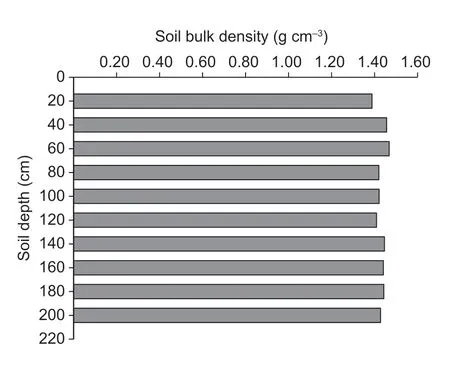
Fig.1 Soil bulk density in 200 cm soil profile with 20 cm increment in this trial field.
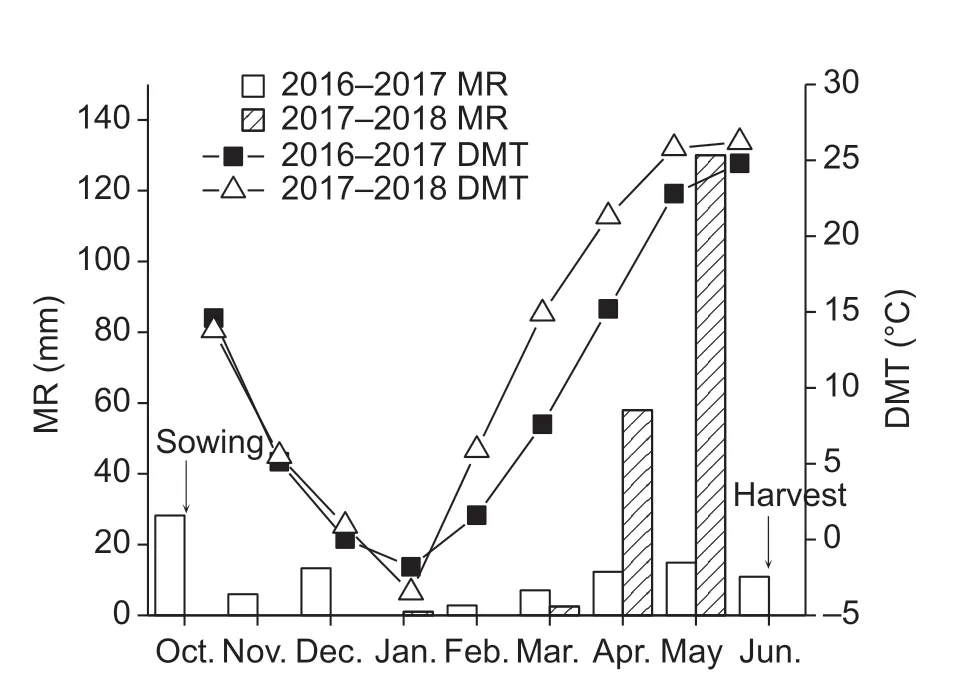
Fig.2 Rainfall and temperature during the two growing seasons. MR,monthly rainfall; DMT,daily mean temperature.
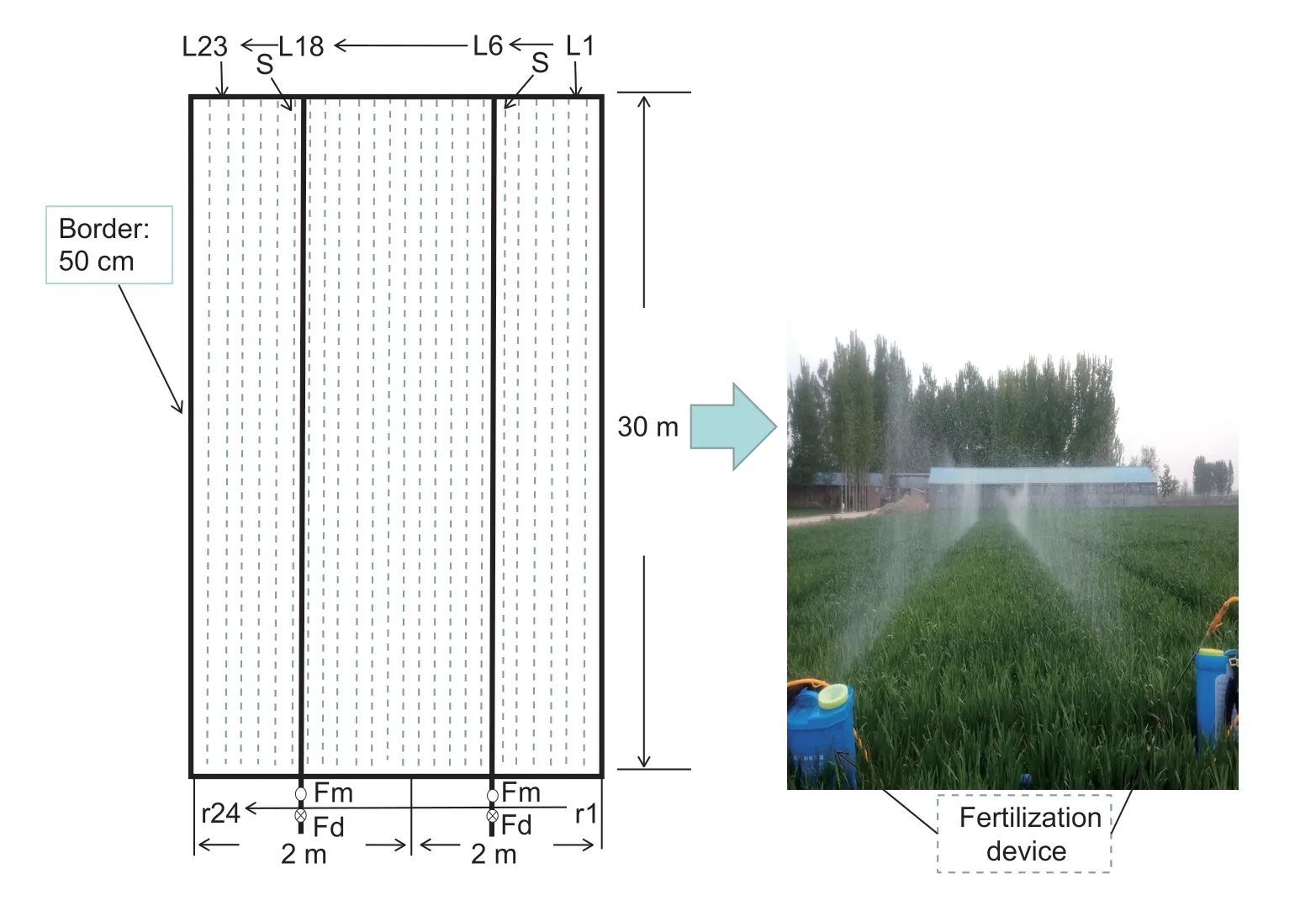
Fig.3 The layout of the hose of micro-sprinkling in each plot. S is the location of the micro-sprinkling hose; r1 to r24 are the rows of winter wheat; L1 to L23 are the inter-rows between two adjacent winter wheat rows; Fd,fertilization device; Fm,flow meter (Li et al. 2019b).

Table 1 The irrigation and nitrogen fertilizer regimes in this study
2.3.Sampling and measurements
LAl and chlorophyll content in flag leavesTen plants(three replicates) were sampled from each experimental plot to determine the green leaf area by a Li-3100 area meter(LI-COR,Inc.,Lincoln,Nebraska,USA) at anthesis and grain-filling stages (20 days after anthesis),after which the area was converted to LAI.
To determine the chlorophyll (a+b) content,20 flag leaves samples (three replicates) were randomly taken from each experimental plot at the anthesis and grain-filling stages (20 days after anthesis) of winter wheat. In this study,0.2 g of chopped plant leaves was extracted in 50 mL of 95% ethanol for 48 h in the dark,and the optical density (OD) values at 649 and 665 nm were obtained with a spectrophotometer(Liet al.2018).
Soil water consumption and utilizationThe soil water content was measured at pre-sowing and maturity stages.Soil samples were collected from 0 to 200 cm at 20 cm intervals with a soil corer. The soil gravimetric water content(g water g−1dry soil) was measured by oven-drying samples at 105°C for 48 h to a constant weight. Some soil samples were retained in each soil layer to determine soil nitrate nitrogen content. The soil volumetric water content (cm3cm–3) was determined from the gravimetric water content(g water g–1dry soil) and bulk density (Fig.1). The amount of soil water extraction was calculated as the difference in the stored soil water (0−200 cm) between pre-sowing stage and maturity stage. Crop seasonal evapotranspiration (ET)was calculated using the soil water balance equation (Zhanget al.2011) as follows:
ET=P+I+ΔSW−R−D+CR
where P (mm) is the rainfall,I (mm) is irrigation,ΔSW(mm) is the extracted soil water based on the difference between the amounts at sowing and maturity,R is runoff,D is drainage below the 200 cm soil profile,and CR is capillary rise into the root zone. Because the groundwater table at the experimental site is 7–9 m (>4 m) below the ground surface,CR is negligible. R and D can also be ignored on the NCP,including the location of the trail site in this study(Wanget al.2013). WUE (kg m–3) was calculated by the following formula (Zhanget al.2018):
WUE=GY/ET
Nitrogen absorption and utilizationThe total nitrogen content in plants was determined using the Kjeldahl method(Dordas and Sioulas 2009). Nitrogen accumulation and nitrogen partial factor productivity (NPFP) were calculated according to the methods of Ruisiet al.(2016) and Siet al.(2020) as follows:
Total N accumulation (TNC)=TDM×NC
NPFP=GY/N application rate
where TDM is the DM of plants at maturity,NC is the nitrogen concentration of above-ground parts in plants and GY is the grain yield.
Soil NO3−-N contents were determined using an ultraviolet spectrophotometer,and soil samples were extracted with 0.01 mol L−1CaCl2(Wanget al.2015). The cumulative amount of NO3−-N within 2 m of soil was calculated as the sum of nitrate accumulation in each layer (Zhang J Tet al.2013).
DM and GYTo measure biomass,the above-ground parts of all plants from two adjacent 50 cm segments (avoiding border rows) in each plot were sampled at anthesis and maturity stages,and were oven-dried at 75°C until a constant weight was reached. DM post anthesis (DMPA)was calculated as the difference between DM at anthesis and maturity stages (Shiet al.2016). The contribution ratio of DM post anthesis to grain yield (CR) was calculated from the ratio of DMPA to GY at maturity. The harvest index (HI)was considered as the ratio of GY to total above-ground DM at maturity.
To determine the spike number (SN),spikes were counted for six wheat lines 1-m long in each plot before harvest. The grain number per spike was determined by counting the kernels in each spike from 60 randomly selected plants in each plot before harvest. At maturity,wheat plants from a 3-m2area in each plot were harvested and threshed for GY determination. The actual GY was reported on a 13% moisture basis. The 1 000-grain weight was calculated by weighing 1 000 seeds from each sample and averaged from three replicates.
2.4.Data analysis
Analysis of variance was performed by Microsoft Excel 2007 and IBM SPSS version 19.0 (SPSS,IBM,USA). Differences were judged by the least significant differences test using a 0.05 level of significance. All figures were created using OriginPro 2016 version 9.3 (OriginLab Corp.,Northampton,MA,USA).
3.Results
3.1.GY and yield components
GY was significantly affected by the year,irrigation and nitrogen treatments (Table 2). GY significantly decreased in 2017–2018 compared with 2016–2017,which was mainly due to the significant decrease in SN and TGW. GY improved with increasing irrigation amount,and there was no significant difference between S120 and S150; compared with that in S150,the yield loss in S120,S90 and S60 was 1.43,11.2 and 18.1%,respectively. The significant decrease in GY in S60 and S90 was caused by the decrease in SN and TWG compared with those in S120 and S150. Compared with those under N2 and N3,the SN and kernels per spike(KPS) under reduced nitrogen application (N1) were slightly affected,while the TGW significantly decreased due to insufficient fertilizer supply. The increase in GY in N2 and N3 was 8.80 and 7.44% higher than that in N1,respectively.However,the effects of nitrogen application rates on GY were different under the different volumes of micro-sprinkling with water and nitrogen combined. Under S60,the GY of N3 was significantly higher than that of N2 because more nitrogen increased the SN and TGW. Under S90,the GY difference between N2 and N3 was not significant due to the small differences in SN,KPS and TGW,but the GY significantly decreased in N1 caused by the decrease in SN and TGW. However,N2 presented the highest GY in S120 and S150,mainly due to the decrease in TGW under insufficient or excessive nitrogen application rates. Overall,under micro-sprinkling irrigation with water and nitrogen combined,GY could be enhanced by increasing nitrogen applications with reduced amounts of irrigation (S60 and S90),while only the optimized nitrogen application (N2)could achieve the highest GY under increased irrigation volumes (S120 and S150).
3.2.LAI
LAI of winter wheat at anthesis was significantly higher than at the filling stage,and it was higher in 2016–2017 than that in 2017–2018 (Fig.4). The two-year experimental results showed that the LAI increased with increasing irrigationand nitrogen applications. In 2016–2017,under the same irrigation amount,the LAI in N1 at anthesis was significantly lower than that in the N2 and N3 treatments,and there was no significant difference in the LAI between N2 and N3 (except S90 in 2017/2018). The LAI increased with the increase in irrigation volume at anthesis,and the plants in N2 and N3 maintained a larger LAI at the filling stage compared with those in N1. In brief,under the conditions of microsprinkling with water and nitrogen combined,increasing irrigation or nitrogen applications could promote the LAI at anthesis and maintain a higher LAI at the filling stage.However,only under a relatively low irrigation volume of micro-sprinkling,the increased nitrogen applications were conductive to improving the LAI at both the anthesis and filling stages.
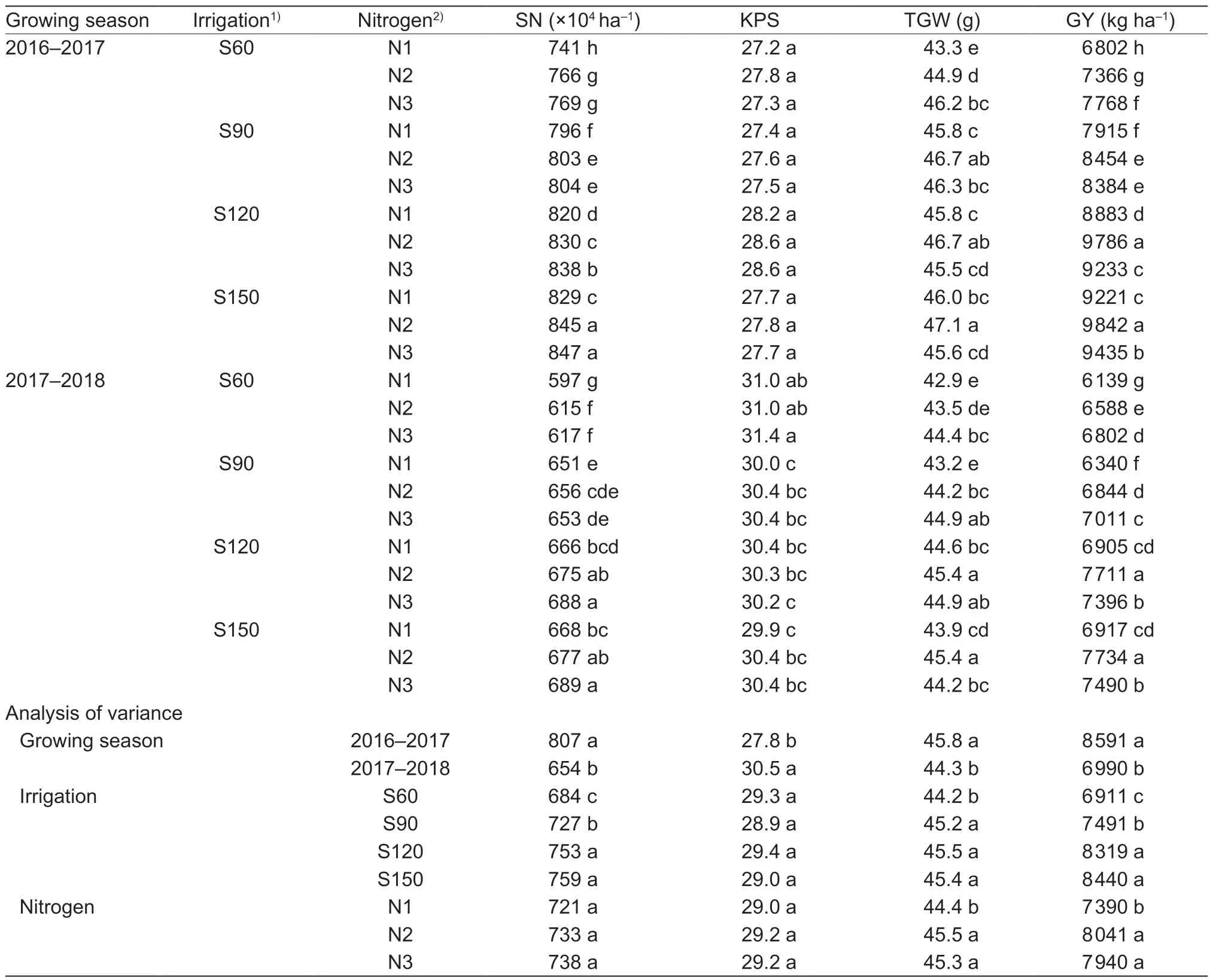
Table 2 Effects of micro-sprinkling irrigation with different nitrogen rates and irrigation amounts on spike number (SN),kernels per spike (KPS),1 000-grain weight (TGW),and grain yield (GY) of winter wheat
3.3.Chlorophyll content of flag leaves
The results of the two-year experiment showed that the chlorophyll content of the flag leaves at anthesis was significantly higher than that at the filling stage (Fig.5).Moreover,the chlorophyll content showed a slight difference between the two growing seasons. The chlorophyll content significantly increased with increasing nitrogen levels under the same irrigation. Similarly,chlorophyll content also increased with the increase in irrigation under the same nitrogen level,particular at the filling stage. The highest chlorophyll content in the flag leaves occurred in the S150N3 treatment.
3.4.DM and HI
In this study,HI differed little between years and between irrigation and nitrogen treatments (Table 3). The DM at anthesis (ADM) and maturity (TDM) and the contribution ratio of post anthesis DM to grain were significantly affected by year. The ADM,TDM and CR in 2016–2017 were significantly higher than those in the 2017–2018 growing season,which could account for the higher GY in that year (Table 2). The ADM,TDM and CR improved with increasing irrigation volume,and there was no significant difference between S120 and S150,the results of which were significantly higher than those of S60 and S90.According to the analysis of variance,nitrogen application had no significant effect on the ADM,TDM or CR. In addition,the increase in nitrogen application was beneficial to the increase in ADM under the same irrigation volume,and the TDM in N2 and N3 was higher than that in the N1 treatment. These findings indicated that under the condition of relatively low irrigation (S60 and S90),increased nitrogen was beneficial to increasing the HI,while micro-sprinkling with increased amounts of irrigation (S120 and S150) and excessive nitrogen application (N3) were unfavorable to increasing the HI. Overall,S120N2 obtained the highest HI in this study.
3.5.Water utilization
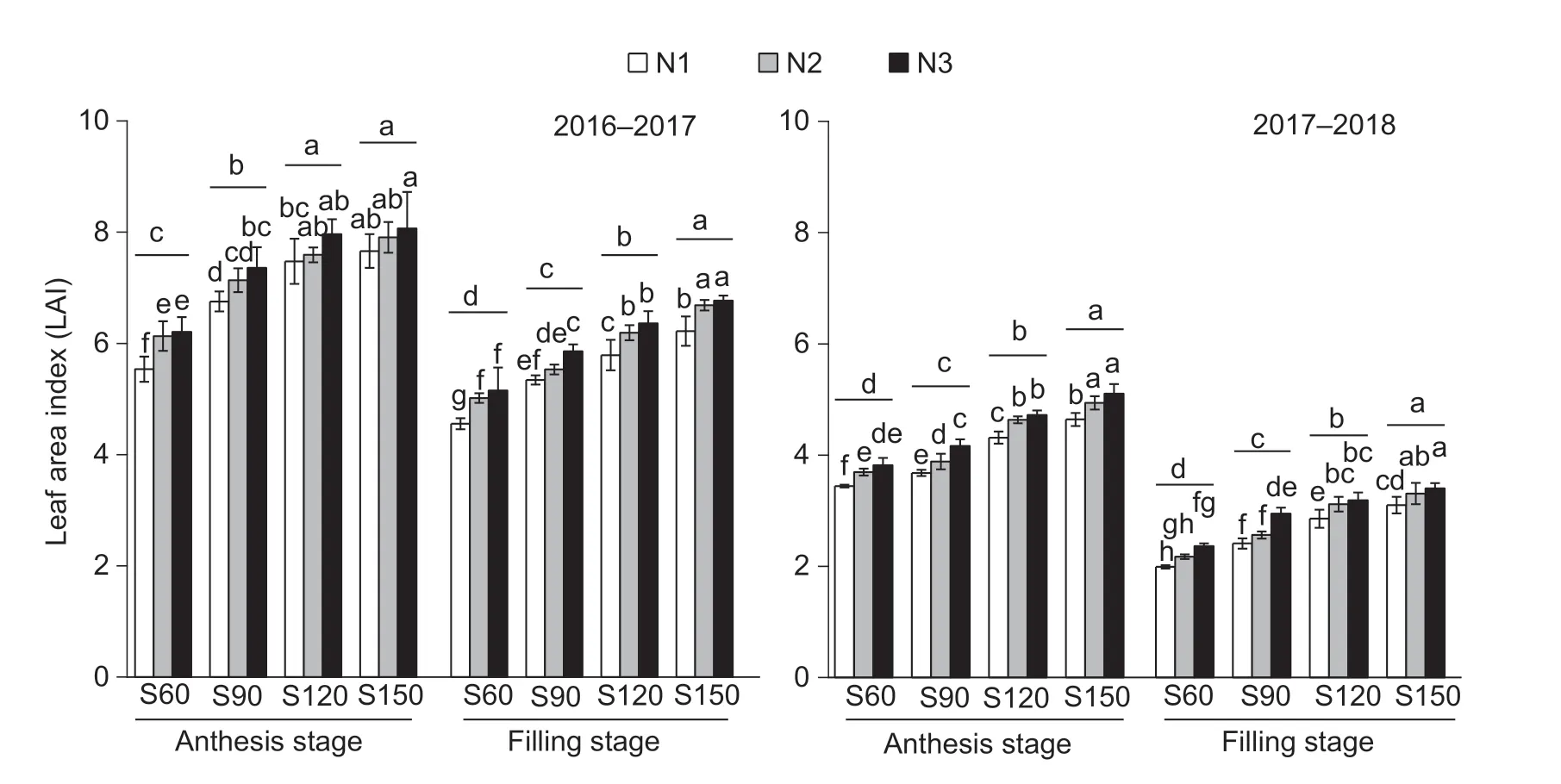
Fig.4 Effects of micro-sprinkling irrigation with different nitrogen rates and irrigation amounts on the leaf area index of anthesis and filling stages. N1,N2 and N3,the nitrogen application rates are 150,195 and 240 kg ha–1,respectively. S60,S90,S120,and S150,the irrigation amounts are 60,90,120,and 150 mm under micro-sprinkling irrigation,respectively. Columns followed by the same letters in the same stage are not significantly different at P<0.05,as determined by the LSD test. Vertical bars represent standard errors (n=3).
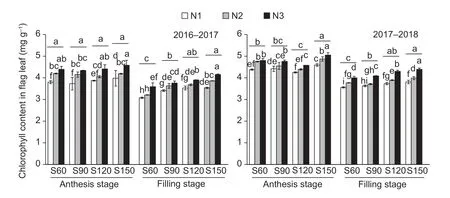
Fig.5 Effects of micro-sprinkling irrigation with different nitrogen rates and irrigation amounts on flag leaf chlorophyll content of anthesis and filling stages. N1,N2 and N3,the nitrogen application rates are 150,195 and 240 kg ha–1,respectively. S60,S90,S120,and S150,the irrigation amounts are 60,90,120,and 150 mm under micro-sprinkling irrigation,respectively. Columns followed by the same letters in the same stage are not significantly different at P<0.05,as determined by the LSD test. Vertical bars represent standard errors (n=3).

Table 3 Effects of micro-sprinkling irrigation with different nitrogen rates and irrigation amounts on dry matter accumulation at anthesis (ADM) and maturity (TDM),and contribution ratio of post anthesis dry matter accumulation to grain (CR) and harvest index (HI) of winter wheat
The ET,soil water consumption (ΔSW) and WUE were greatly affected by year,irrigation and nitrogen treatment(Table 4). The ET,∆SW and WUE significantly decreased in 2017–2018 compared with those in the previous season,and lower WUE in 2017–2018 was mainly due to lower GY during that season (Table 2). There was no significant difference in ET between S90,S120 and S150,the ET values of which were significantly higher than the value in S60. Moreover,there was no significant difference in ΔSW between S60 and S90,but they were significantly higher than that of S120 and S150,and there was no significant difference between S120 and S150. The WUE significantly increased with the increase in irrigation volume,but there was no significant difference between S120 and S150. Compared with the ET in N2 and N3,the ET in N1 significantly decreased,and N3 extracted the greatest amount of ΔSW,while N2 achieved the highest WUE. On the basis of the two-year experimental results,a higher WUE was achieved in N2 under micro-sprinkling with different irrigation volumes(except S60),while excessive nitrogen application (N3)significantly decreased the WUE in S120 and S150. Overall,under micro-sprinkling with water and nitrogen combined,the WUE could be improved by increasing nitrogen in the low-irrigation treatment (S60),while only suitable amounts of nitrogen (N2) were needed to achieve the highest WUE.In the present study,S120N2 obtained the highest WUE.From the results of the water consumption within different profiles of 2 m of soil at maturity (Fig.6),the difference among N levels in 0–120 cm soil layer was small under S60 in 2016–2017,while the water consumption below 120 cm was significantly increased with increasing nitrogenlevels. Under S90,the increase in nitrogen levels promoted the absorption and utilization of soil water and especially promoted the utilization of relatively deep soil water.Under S120 and S150,the upper soil water consumption increased with increasing nitrogen levels,while below 120 or 140 cm,the soil water consumption of N2 was higher than that of N1 and N3,and the difference between N1 and N3 was small. Overall,the increase in nitrogen rates could promote the absorption and utilization of deep soil water under micro-sprinkling with relatively low amounts of irrigation,while the increase in nitrogen application increased the water consumption in the upper soil under micro-sprinkling with increased amount of irrigation and reduced both the absorption and utilization of deep soil water,especially in the N3 treatment.
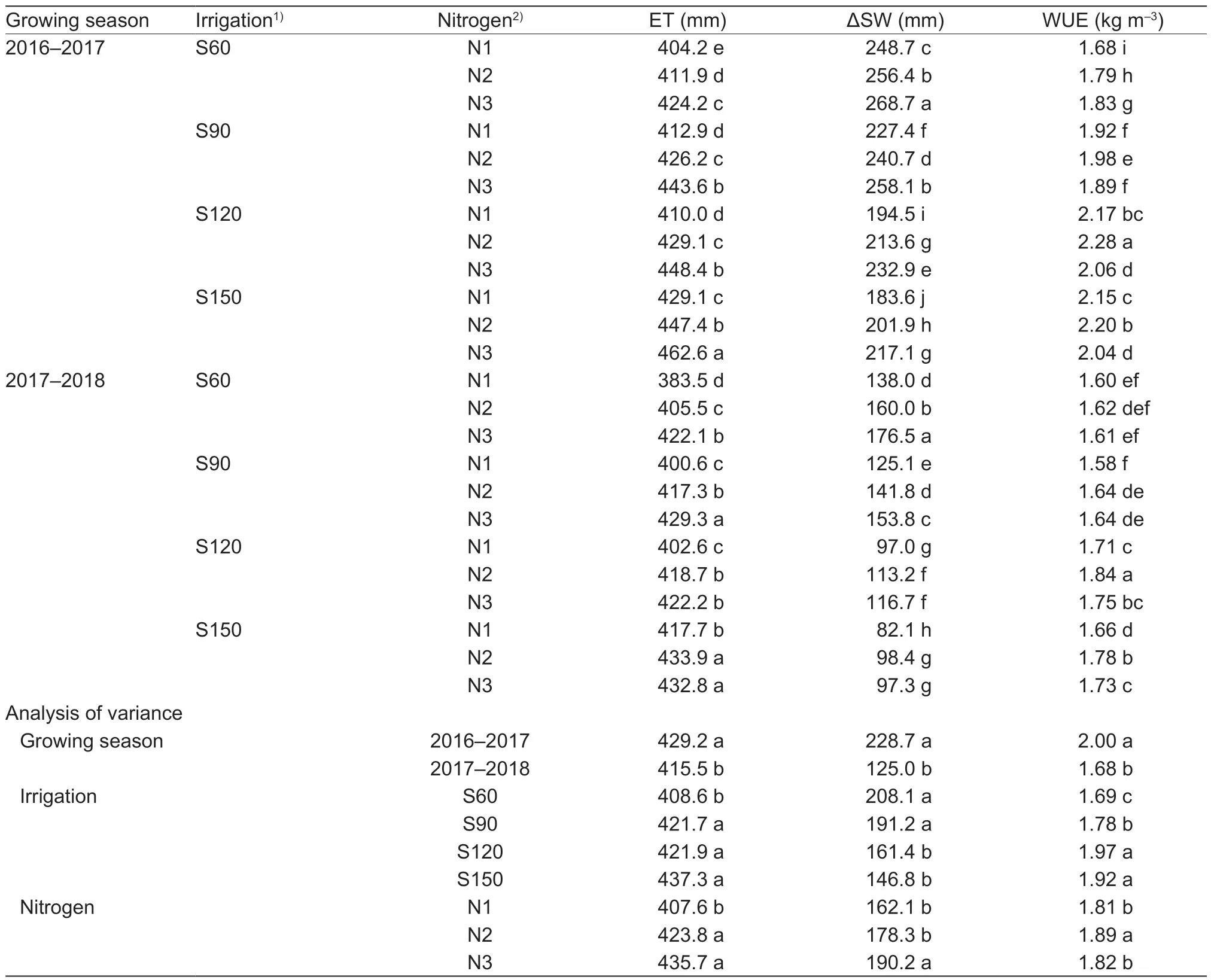
Table 4 Effects of micro-sprinkling irrigation with different nitrogen rates and irrigation amounts on the seasonal water consumption(ET),soil water consumption (ΔSW) and water-use efficiency (WUE) in winter wheat
3.6.Nitrogen utilization
The total nitrogen accumulation (TNC) at maturity,soil nitratenitrogen residue (SNC) and NPFP were significantly affected by year,irrigation and nitrogen treatment (Table 5). The TNC was significantly decreased in 2017–2018 compared with 2016/2017,and lower TNC in 2017–2018 was mainly due to the inadequate TDM at maturity during that season (Table 3).The SNC in 2017–2018 significantly increased compared to that in 2016–2017,which significantly decreased the NPFP.The TNC increased with increasing irrigation volume,and there was no significant difference between S120 and S150.Moreover,the difference in SNC between S60,S90 and S120 was not significant,but the SNCs of these treatments were significantly lower than the SNC of S150; the NPFP increased with increasing irrigation,and there was no significant difference between S120 and S150. Compared with that in N1,the TNC in N2 and N3 significantly increased,and there was no significant difference between N2 and N3;however,the SNC significantly increased with increasing nitrogen application,while the NPFP significantly decreased.The results showed that the TNC increased with increasing nitrogen application in S60 and S90,while there was little difference between N2 and N3 in S120 and S150. Overall,under micro-sprinkling with water and nitrogen combined,the TNC could be improved by increasing the nitrogen in the low-irrigation treatments (S60 and S90),while there was no significant difference between N2 and N3 in S120 and S150;N1 achieved the highest NPFP in this study. The soil nitrate nitrogen (NO3–-N) decreased first but then increased with increasing soil depth in the 2016–2017 growing season,and soil NO3–-N content below 100 cm was significantly higher than that in the upper soil layer in all treatments (Fig.7).Under S60 and S90,the NO3–-N content in the deep layer of N3 was significantly higher than that of N1 and N2,and the NO3–-N content in the deep layer of N2 was slightly higher than that of N1,which may be due to the surplus of soil nitrogen under the high-N treatment. There was no significant difference in the content of NO3–-N between the N2 and N3 treatments in the soil layer above 140 cm under S120,and the content of NO3–-N in the soil layer below 140 cm increased with increasing nitrogen. Under S150,the difference of soil NO3–-N content between N1 and N2 was small,but the content was significantly lower than that of N3,which indicated that increased amount of irrigation and excessive nitrogen applications under micro-sprinkling irrigation may lead to NO3–-N leaching into the deep soil layer.
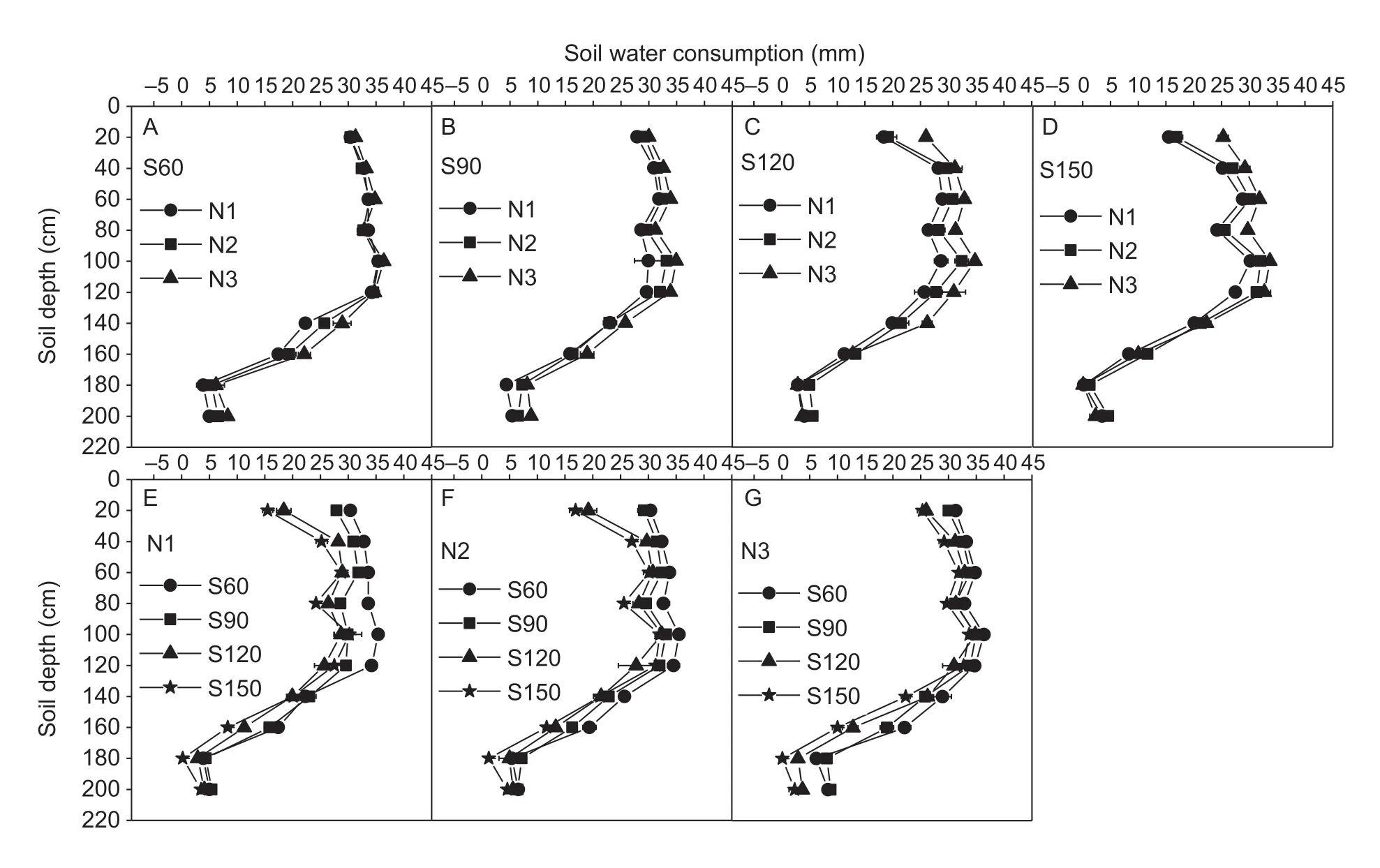
Fig.6 Effects of micro-sprinkling irrigation with different nitrogen rates and irrigation amounts on water consumption of different soil layers in 2-m soil profile at maturity of winter wheat in 2016–2017 growing season. N1,N2 and N3,the nitrogen application rates are 150,195 and 240 kg ha–1,respectively. S60,S90,S120,and S150,the irrigation amounts are 60,90,120,and 150 mm under micro-sprinkling irrigation,respectively. Bars represent standard errors (n=3).
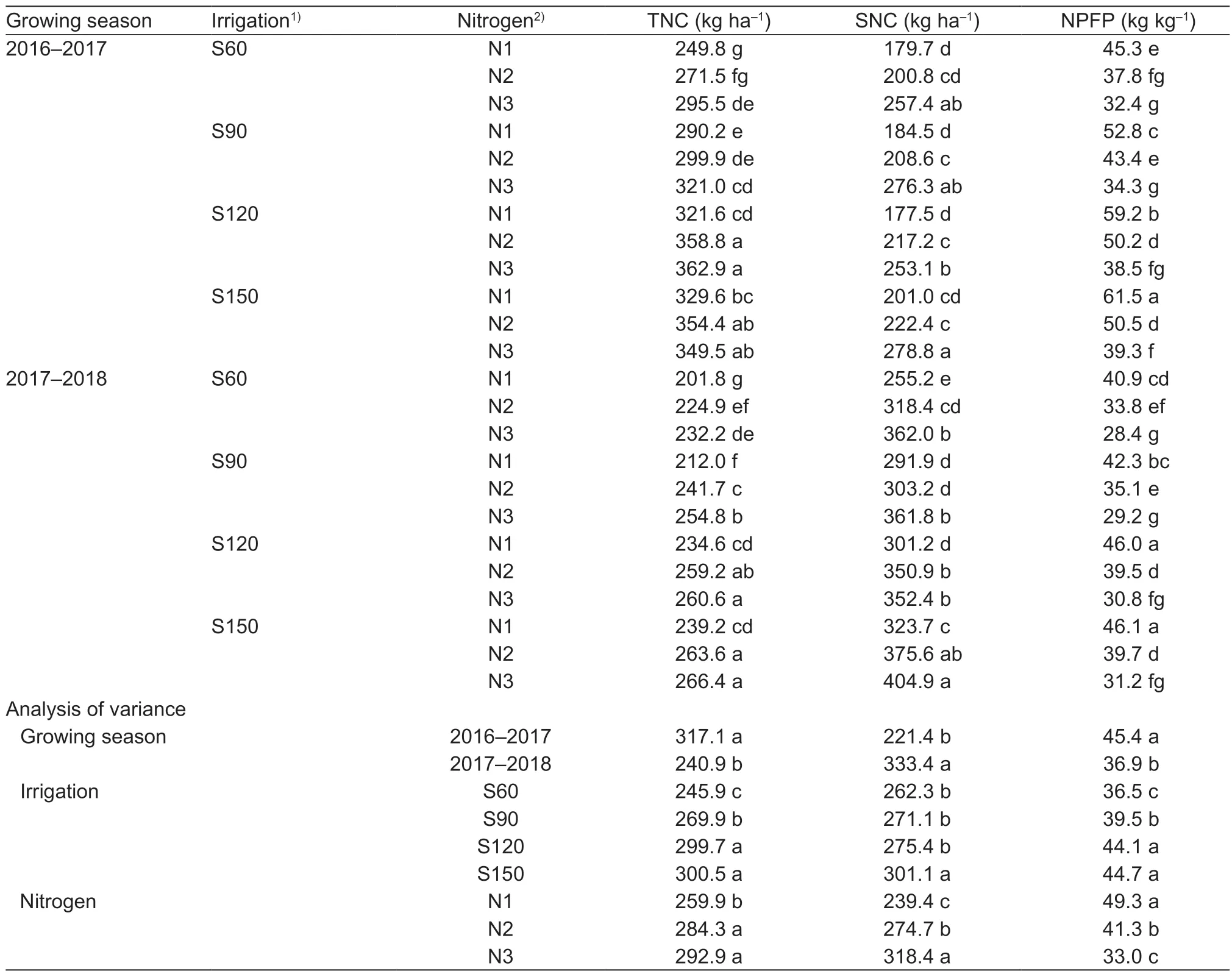
Table 5 Effects of micro-sprinkling irrigation with different nitrogen rates and irrigation amounts on total nitrogen accumulation(TNC),soil nitrate nitrogen residue (SNC) and nitrogen partial factor productivity (NPFP) of winter wheat
4.Discussion
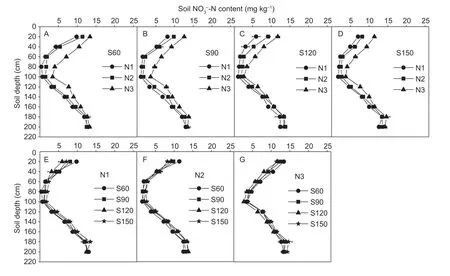
Fig.7 Effects of micro-sprinkling irrigation with different nitrogen rates and irrigation amounts on soil NO3–-N of different soil layers in 2-m soil profile at maturity of winter wheat in 2016–2017 growing season. N1,N2 and N3,the nitrogen application rates are 150,195 and 240 kg ha–1,respectively. S60,S90,S120,and S150,the irrigation amounts are 60,90,120,and 150 mm under micro-sprinkling irrigation,respectively. Bars represent standard errors (n=3).
Many researchers have reported that crop yields are significantly affected by irrigation quotas and nitrogen application rates,and excessive irrigation or nitrogen supplies can hinder wheat production and reduce WUE and nitrogen-use efficiency (Yanget al.2015; Liet al.2019b; Xuet al.2020). However,the loss of GY caused by inadequate irrigation can be compensated for by appropriate increases in nitrogen fertilizer in fields in dryland regions (Daiet al.2015),while excessive nitrogen application under sufficient irrigation can cause nitrogen leaching and decreases nitrogen fertilizer-use productivity (Liet al.2019a). In this study,the GY of wheat was enhanced by increasing nitrogen applications under the relatively low irrigation amount from micro-sprinkling,particularly in S60,which was mainly due to the increase in TGW (Table 2). While N2 yielded the highest GY in S120 and S150,excessive nitrogen supplies significantly decreased the TGW and GY. These findings are in agreement with those of previous studies,i.e.,microirrigation with increased amounts of moisture and excessive nitrogen adversely affected the promotion of GY of winter wheat (Jhaet al.2019; Liet al.2019a). Although increased amounts of nitrogen could improve the GY under microsprinkling with low amounts of irrigation in the present study,the WUE and NFFP were not improved in S60 and S90,and NFFP greatly decreased with an increase in nitrogen application (Tables 4 and 5). In terms of GY,WUE and NPFP,S120N2 was the best treatment in this study.
4.1.Effects of irrigation and nitrogen application scheduling on the dry matter production post anthesis and crop yield
Improving DM post anthesis (DMA) is a highly promising approach to increase GYs of winter wheat (Shiet al.2016;Liet al.2018). DMA is directly related to the flag leaf photosynthesis rate,and maintaining a relatively high LAI and chlorophyll content is beneficial to improve the biomass to increase grain weight and GY (Wanget al.2013; Xuet al.2018). However,the LAI and leaf chlorophyll content in wheat during the filling stage are greatly affected by irrigation amount and nitrogen application (Zhanget al.2016). In this study,micro-sprinkling with increasing amounts of irrigation or nitrogen improved the LAI and leaf chlorophyll content at the filling stage,although the difference in the LAI between N2 and N3 was not significant (Figs.4 and 5). At maturity,there was no significant difference in the DM between N2 and N3 under the same irrigation amount,and the increase in GY under relatively low irrigation with increasing nitrogen application under micro-sprinkling was mainly due to the improvement of the HI,and N2 yielded the highest HI under S120 and S150 (Tables 2 and 3). Moreover,the contribution of post anthesis DM to grain yield (CR) increased with increasing micro-sprinkling irrigation amount,but nitrogen application rate had no significant effect on the CR (Table 3),which contrasts with the results of previous reports (Tianet al.2018; Zhaiet al.2019). Studies have indicated that excessive nitrogen application under the appropriate irrigation amounts can delay crop maturation and can decrease grain weight,the HI and wheat production (Liet al.2016; Wang Det al.2017). In the present study,excessive nitrogen application (N3) under S120 and S150 resulted in an excessively high flag leaf chlorophyll concentration during the filling period,which may reduce the grain weight and the GY (Fig.5; Table 2).
4.2.Effects of irrigation and nitrogen application scheduling on water and nitrogen use
Studies have shown that the timing and amount of irrigation greatly influence the growth and production of winter wheat,thus affecting the utilization efficiency of irrigation water resources (Zhanget al.2015; Wang H Yet al.2017).Nitrogen application also has a significant effect on WUE,and too much nitrogen supply can lead to a decrease in deep soil moisture extraction,which is not conducive to the improvement of resource-use efficiency (Liet al.2019a). In this study,the WUE significantly increased with increasing irrigation amount under micro-sprinkling,while there was no significant difference between S120 and S150 (Table 4),which was mainly due to the comparable GY in those two treatments (Table 2). However,the WUE increased with increasing nitrogen application under micro-sprinkling with less irrigation,but there was little difference between N2 and N3; compared with that in N2,the WUE in N3 significantly decreased under S120 and S150,mainly due to the decrease in TGW and GY under excessive nitrogen application and increased amounts of irrigation (Table 2).These research results indicated that the application of nitrogen fertilizer had different effects on WUE under different micro-sprinkling irrigation amounts.Improving the utilization of deep soil moisture in winter wheat is an important approach to guarantee production on the NCP.Soil moisture extraction and utilization can be enhanced by properly reducing the irrigation amount,thus improving the WUE (Xuet al.2016; Wanget al.2018). Moreover,nitrogen application rates have a great influence on the absorption of soil moisture,and excessive application of nitrogen significantly reduces the utilization of stored water within deep soil profiles (Vázquezet al.2006; Gheysariet al.2009). In this study,the soil water consumptions in S60 and S90 were significantly higher than those in S120 and S150(Fig.6). In S60,there was no significant difference in the water consumption in the upper soil layer between nitrogen treatments,while the soil water consumption within deep soil (below 120 cm) increased with an increase in nitrogen application. However,in S90,S120 and S150,increased amounts of nitrogen application increased the soil water consumption above the 120 cm soil profile,but there was little difference in soil water extraction below the 140 cm soil layer between the N treatments (Fig.6). These findings are consistent with previous research findings that excessive nitrogen application reduced the absorption of deep water(Chenet al.2018).
Studies have indicated that the appropriate nitrogen rate can promote the absorption and utilization of water and nitrogen stored in the deep soil of winter wheat and can increase GYs (Zanget al.2012),while excessive application of nitrogen has a negative effect on production,which results in wasted nitrogen fertilizer,polluting the environment and groundwater resources (Zhang X Yet al.2013; Liet al.2016). Nitrogen lost in the soil is mainly in the form of nitrate-nitrogen (NO3–-N),which can leach with soil moisture to the deep layer,and the NO3–-N content in the soil is mainly affected by nitrogen application (Latiri-Soukiet al.1998; Wanget al.2015). The soil moisture content also has a great influence on the availability of soil nitrogen,and the appropriate soil water content is conducive to the absorption of nitrogen and improves the absorption and utilization of soil-stored water at the same time (Garnettet al.2009). In this study,under S60 and S90,the increase in nitrogen application increased the plants’ nitrogen accumulation at maturity,while there was no significant difference between N2 and N3 in S120 and S150,but the nitrogen accumulation in these treatments was significantly higher than these in the N1 treatment (Table 5). In addition,in this study,the distribution of nitrate-nitrogen in the 2-m soil layer at maturity showed that,under the conditions of micro-sprinkling with water and nitrogen fertilizer combined,the increase in nitrogen application with increased amounts of irrigation led to the increase in residual nitrate-nitrogen in soil at maturity,which is also consistent with our previous research (Liet al.2016).
Many studies have shown that different irrigation methods,environmental factors and soil moisture conditions have a great impact on carbon and nitrogen emissions from farmland (Yeet al.2018). In the present study,the water content in the upper soil profile of S60 and S90 was low at the critical growth stage due to the smaller amount of water applied during each irrigation event,especially in S60,and the nitrogen fertilizer was mainly concentrated within the surface soil layer (Figs.5 and 6). In this present study,the water content in the upper soil profile of S60 and S90 was low at the critical growth stage due to the smaller amount of water applied during each irrigation event,especially in S60,and the nitrogen fertilizer was mainly concentrated within the surface soil layer (Figs.6 and 7). Whether relatively low amounts of irrigation resulted in the loss of nitrogen in other forms (such as N2O) has not been reported. Overall,under the conditions of micro-sprinkling irrigation with water and nitrogen combined,the effect of different irrigation amounts and nitrogen application rates on the greenhouse gas emissions need to be further studied.
5.Conclusion
In this study,under micro-sprinkling with water and nitrogen combined,irrigation amount had a significant impact on GY,WUE and NPFP. These parameters increased first and then remained stable with an increase in irrigation,and there was no significant difference between S120 and S150,the parameters of which were significantly higher than those in other irrigation treatments; compared with N1 and N3,N2 obtained a higher GY and WUE,while N1 obtained the highest NPFP. Moreover,the effect of nitrogen application rates on GY was different under the different irrigation amounts,and the increase in nitrogen application rate was beneficial to the increase in GY under low amounts of irrigation due to the increase in TGW,while under increased amounts of micro-sprinkling irrigation,the GY in N2 was the highest mainly due to insufficient or excessive nitrogen application rates leading to the decrease in TGW. Overall,considering the GY,WUE and NPFP,S120N2 is the optimal high-yielding and efficient production treatment for winter wheat on the NCP.
Acknowledgements
This study was funded by the National Key Research and Development Program of China (2016YFD0300105 and 2016YFD0300401),the National Natural Science Foundation of China (31871563) and the earmarked fund for China Agriculture Research System (CARS-3).
杂志排行
Journal of Integrative Agriculture的其它文章
- Closing crop yield and efficiency gaps for food security and sustainable agriculture
- lmproving maize grain yield by formulating plant growth regulator strategies in North China
- Effects of deep vertical rotary tillage on the grain yield and resource use efficiency of winter wheat in the Huang-Huai-Hai Plain of China
- Effects of mechanized deep placement of nitrogen fertilizer rate and type on rice yield and nitrogen use efficiency in Chuanxi Plain,China
- lmproving grain yield,nitrogen use efficiency and radiation use efficiency by dense planting,with delayed and reduced nitrogen application,in double cropping rice in South China
- Differences of yield and nitrogen use efficiency under different applications of slow release fertilizer in spring maize
